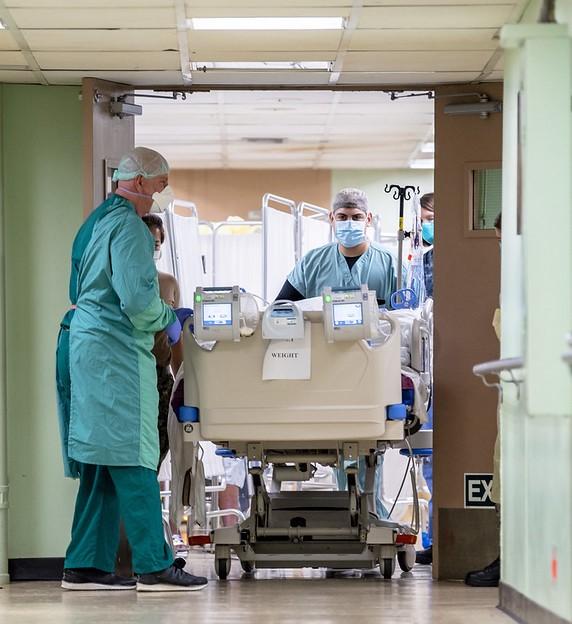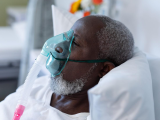In the months since the novel coronavirus emerged in China and began spreading around the globe, reports of bacterial co-infections and widespread antibiotic use in COVID-19 patients has prompted concerns that the unprecedented viral pandemic, on top of the devastation it has already caused, could have the downstream effect of diminishing antibiotic supplies and further fueling rates of antibiotic resistance.
Even though COVID-19 is caused by a virus—SARS-CoV-2—and antibiotics should have no effect on it, those concerns aren't unfounded. Clinicians have frequently had to resort to antibiotics for COVID-19 patients because of clinical uncertainty, the risk of secondary bacterial infections in patients with underlying conditions and lengthy hospitalizations, and most of all, a lack of any other proven treatment.
To date, the picture on antibiotic use in in COVID-19 patients is incomplete but worrisome. An early study from Wuhan, China, where the pandemic originated, indicated nearly all hospitalized patients were receiving antibiotics. A recent review of COVID-19 studies published since the pandemic began found that while only 8% of COVID-19 patients had documented bacterial co-infections, 72% had received antibiotic therapy.
Clinicians in the United States say that, in the face of a pathogen that causes what looks like a typical case of pneumonia but can cause patients' conditions to deteriorate quickly and lead to other bacterial infections in some severely ill patients, antibiotics are at least a known quantity, even if they're unlikely to help.
"I think, undoubtedly, we've seen more antibiotic use, because sometimes clinicians are unsure…and there really are no effective treatments for COVID-19," says Anurag Malani, MD, medical director for the infection prevention and antimicrobial stewardship programs at St. Joseph's Mercy Health System in Ann Arbor, Michigan.
"I think the hardest thing to do as a doctor is nothing, even if nothing is the right answer," says Valerie Vaughn, MD, a hospitalist at the University of Michigan's academic medical center, also in Ann Arbor.
But conversations with these clinicians and others who've been treating COVID-19 patients suggest that even in the face of the initial surge of coronavirus infections, antibiotic stewardship principles have helped guide as much appropriate use as possible. And they believe those principles will help limit antibiotic use as the pandemic continues.
Antibiotic use in COVID-19 patients
Both Vaughn and Malani work in a state that was among the hardest hit by the coronavirus. And they say that with the crush of severely ill patients arriving in hospitals starting in late March, it was hard to avoid antibiotic use.
"In the beginning we were caring for lots and lots of critically ill patients, and it was difficult to keep up with the amount of volume," says Malani. "Because you're dealing with really critical situations and often likely death, there's been a tendency, when all is said and done, to use things that there wasn't really evidence for."
Vaughn separates the antibiotic use into two groups of patients. The first was the patients who were coming in with symptoms of severe community-acquired pneumonia. Because the COVID-19 test results weren't coming back for several days, and there was a possibility that some of the patients could have bacterial pneumonia, most of these patients were treated with empiric antibiotics.
"You're not going to wait 5 days to give a patient antibiotics, so patients were being treated for bacterial pneumonia just in case," Vaughn says.
And that's pretty typical, says Neil Clancy, MD, chief of infectious diseases at the Veterans Affairs (VA) Pittsburgh Healthcare System. "In the pre-COVID-19 era, if you saw those people, maybe you'd think influenza, but you'd probably empirically, at least, begin to treat for community-acquired pneumonia," he says.
But early on, Vaughn says, many of these patients were getting broad-spectrum antibiotics, which are generally reserved for pneumonia patients whose infection may be caused by drug-resistant pathogens like methicillin-resistant Staphylococcus aureus (MRSA).
"I think people were just worried because this population got sick so much quicker than we see with normal pneumonia," she says. "From room air to intubation in 12 hours. So people were treating broader than they normally would."
Vaughn says she and her antibiotic stewardship program colleagues worked quickly to correct the unnecessary broad-spectrum prescribing, making sure that patients with no risk factors for MRSA received narrower-spectrum drugs. Then they made sure that antibiotics in patients who tested positive for COVID-19 were stopped—unless there was a concern about a secondary bacterial infection. Now, with COVID-19 test results coming back quickly, they can withhold antibiotics until they get an answer.
"We can actually say 'let's not treat these patients with antibiotics at all,' " she says.
But for the more severely ill patients that end up in the intensive care unit (ICU) and on ventilators—the second group that Vaughn described—secondary bacterial infections are a big concern, and broad-spectrum antibiotics are often needed. These patients, frequently older and with underlying conditions, are the ones who typically get bacterial infections in the hospital, because their immune system has been compromised and they're spending weeks in an environment where bacteria is rampant.
"The co-infections we're seeing are happening in these critically ill patients after they've been in the hospital awhile, after they've been intubated, after they've been given IL-6 inhibitors and that kind of thing," Vaughn says.
IL-6 inhibitors are drugs used to ameliorate severe lung tissue damage in COVID-19 patients. Malani explains that these and other drugs being used in patients with severe illness may be compounding the risks of bacterial co-infections, which his hospital is also seeing a fair share of among COVID-19 patients.
"We're beginning to look at our data, and I would say it's probably been between 15% and 20%, which is pretty in line with what's been reported [elsewhere]," Malani says.
Clancy says in his experience at the VA Pittsburgh Healthcare System, which he notes has not to this point been overwhelmed by COVID-19 cases, there's also a third group of patients who are coming in to the hospital with both COVID-19 and bacterial co-infections, like urinary tract infections and Clostridioides difficile.
"Part of it is that the people who are most likely to likely to get hospitalized and get really sick with COVID-19 also have risk factors for run-of-the-mill bacterial infections," he says. "They're diabetics, or they have heart and lung disease…and what you need to do there, from a stewardship perspective, is treat them [with antibiotics] when they come, but treat them as narrowly as possible."
Data will aid stewardship going forward
For Debbie Goff, PharmD, a pharmacist who specializes in infectious diseases and antibiotic stewardship at The Ohio State University Wexner Medical Center in Columbus, the amount of antibiotic prescribing occurring in COVID-19 patients is understandable but frustrating.
"I really can't fault them [clinicians] for trying to do whatever they can," Goff says, because the mortality rate of COVID-19 is frightening and they have little else to work with. "But the antibiotic prescribing is going on almost across the board in COVID-19 patients because we lack the ability to diagnose bacterial infections rapidly. This is why we need respiratory rapid diagnostic tests in US hospitals."
Goff hopes that now that cases appear to be slowing down in the United States, hospitals can go back and look at data on COVID-19 patients to see how many received antibiotics and how many got bacterial or fungal co-infections and identify the factors that put COVID-19 patients at risk for those infections.
"Data gives you knowledge to make good decisions…and then knowledge gives you power to make informed medical decisions," she says. "We've been making very many emotional decisions, and rightfully so, but now as we get more data, we have to move to science."
Clancy thinks that will happen as hospitals in the harder-hit areas of the country catch their breath. "I think as places that have been really busy early on get to the stage where they're less busy, they'll be able to systematically put stewardship in place," he says.
"I think the hope is that by understanding where we were, and where we're going, we will be able, from a stewardship standpoint, to be better aware of what's coming," says Malani.
While there is concern that widespread antibiotic use in COVID-19 patients could increase the selective pressure for antibiotic resistance, Clancy cautions that it's too soon to tell. He also says if there is an increase in antibiotic resistance, it will likely be found in hospitals or specific hospital units that saw a lot of COVID-19 patients. "It may be that the overall pressure for resistance isn't as dire as the worst-case scenarios might suggest," he says.
But the potential harms that antibiotics can cause, like C difficile infections, are also a reason to be concerned, says Vaughn.
"There are real harms associated with antibiotics," she says. "So…remembering that these [drugs] aren't completely benign, and that we should only be using them when they are absolutely necessary, is what we need to do."
At this point, there is little current data to indicate how antibiotic use in COVID-19 patients is impacting antibiotic use nationwide. Shortages of the antibiotic azithromycin have been reported to the Food and Drug Administration, likely because of the use of the drug with the antimalaria medication hydroxychloroquine, a combination that showed some promise in reducing SARS-CoV-2 viral load in a small French study and has been widely adopted, despite little evidence of benefit in COVID-19 patients.
But Clancy notes that with many elective procedures being cancelled and patients with other conditions avoiding healthcare, some hospitals in areas of the country less hard hit by COVID-19 are actually seeing antibiotic use plummet.
"We've looked at our numbers here, and our numbers are down 40% in terms of overall antibiotics use, and I think we're pretty representative of the nation as a whole," he says.
Parallels between COVID-19, antibiotic resistance
Regardless of how COVID-19 is impacting current antibiotic use, people who've been warning about the crisis of antibiotic resistance and the lack of new antibiotics to treat multidrug-resistant pathogens say the pandemic highlights the need to be prepared for the emergence of an infectious disease, whether it's viral or bacterial.
"Seventeen years ago, when I was leading the CDC, we worried about antibiotic resistance complicating the care of SARS patients," former CDC Director Julie Gerberding, MD, now with pharmaceutical company Merck, wrote recently for Stat News. "We knew then that America's arsenal of antibiotics was not sufficient to guarantee we could manage a large outbreak of drug-resistant bacteria. Since then, these bacteria have only become more widespread, more deadly, and far more difficult to treat, yet our stable of antibiotics to manage them has barely increased."
Clancy says the pandemic is a signal to global health officials and policy makers that the antibiotic pipeline needs to be bolstered before the emergence of an untreatable bacterial pathogen.
"You're seeing now the scramble to get antivirals, to get vaccines, to figure out what we're doing," he says. "If you don't sustain the antibiotic pipeline, and something new arises, then you'll be going through the same scramble. But the timeline for antibiotic development is so much longer."
Goff believes the pandemic could give antibiotic stewardship and development advocates a chance to revise their messaging, which she says has failed to resonate with the public. She cites a recent Wellcome Trust report that found that one of the reasons for a lack of public engagement on antibiotic resistance is the failure of stakeholders to effectively communicate the dangers in a way that makes sense or conveys the urgency of the problem.
Using COVID-19 as an example of how an untreatable infectious disease can turn everything upside down could be a way to break through, Goff says.
"See what happens when you have no therapy to treat an infection?" she asks, previewing a potential talking point. "Well, we're already there with antibiotics, grasping for anything that might work."
























